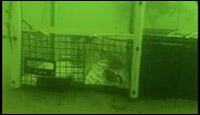 A lobster at Wallis Sands |
|
 Win Watson diving at Wallis Sands |
|
 Jen and Win diving at Wallis Sands |
|
 Video of LTV underwater (click to play) |
LTV Study Site - Wallis Sands
We focused our initial studies with LTV at the Wallis Sands study site because it is dominated by a sandy substrate which makes it very easy to obtain accurate estimates of lobster density using SCUBA divers (see images). In addition, there is a seasonal fluctuation in the density of lobsters so that we can obtain catch and LTV data over a range of densities. Click to enlarge images.
Currently, most of our work with LTV is taking place in a cover near Newcastle Commons and the UNH Coastal Marine Laboratory. At this location we are using LTV and ultrasonic telemetry to measure the attraction of lobsters to traps. For more information about this study site go to the ultrasonic telemetry pages of this website.
